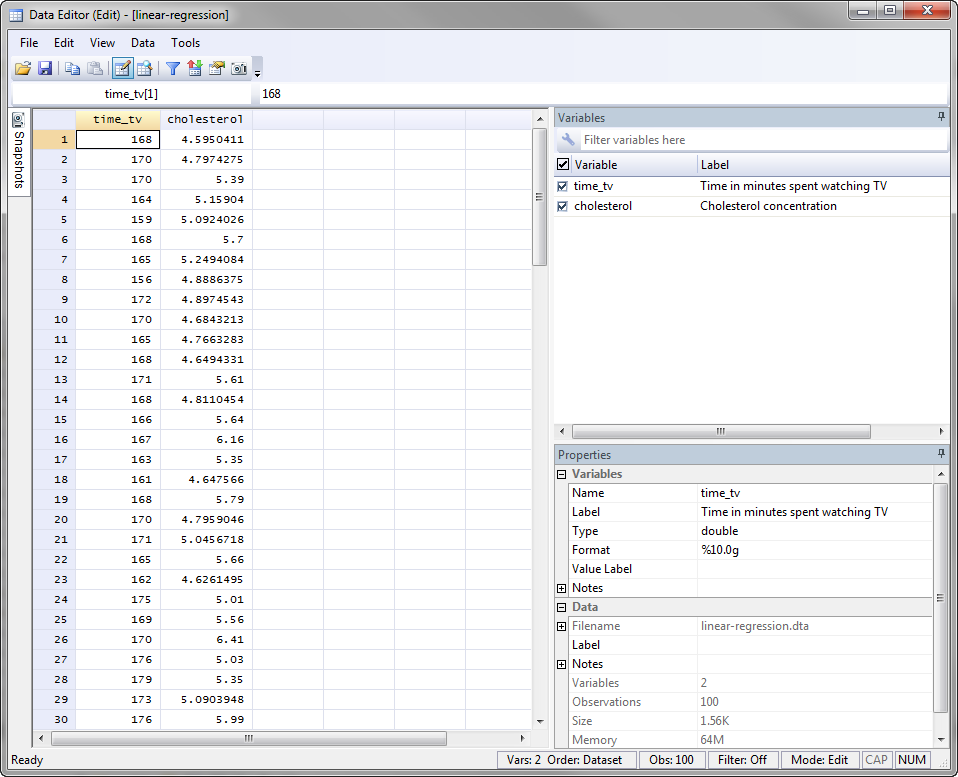
Y i,t X i,tb + u i + v i,t That is, u i is the fixed or random effect and v i,t is the pure residual. Non-Linearity.Stata fits fixed-effects (within), between-effects, and random-effects (mixed) models on balanced and unbalanced data. Step 1: Load and view the data.Below is a breakdown of the variables included in our model to help us keep track of the types of variables we are working with.Note that linearity of the regression model in OLS depends on the linearity of the parameters and not the linearity of the explanatory variables. Use the following steps to perform linear regression and subsequently obtain the predicted values and residuals for the regression model. We’ll use mpg and displacement as the explanatory variables and price as the response variable. For this example we will use the built-in Stata dataset called auto.
Stata Regression Code For The
This is a continuous level variable measuring the age of each respondent. Age of respondent in years ( age). Chatterjee and Hadi(2012) explain regression analysis by using examples containing typical This is a continuous variable that ranges from a score of 2.30 to 49.92, which is a large range! If you would like to investigate this variable more use the code for the descriptive statistics to better understand the distribution, which is very important for a linear regression model.and Trivedi(2010) discuss linear regression using econometric examples with Stata.Mitchell(2012) shows how to use graphics and postestimation commands to understand a tted regression model.
Language of respondent ( language). This is a continuous level variable measuring the number of years of education each respondent has. Education of respondent in years ( education). This is a nominal level variable measuring the sex of each respondent and is coded as 1= FEMALE and 2=MALE.
This is equal to $\beta_0$, the intercept of the model where our regression line intersects with the y axis when $x$ is zero. $_i$, is our dependent variable of the model that we are predicting with four independent variables of a specific observation $i$. $Y_i=\ \beta_0+\ \beta_1x_1+\beta_2x_2\ldots+\beta_kx_k+\varepsilon$Formula 2 is specific to our analysis that includes our dependent variable wages and our independent variables age, sex, education, and language.2. Language is coded as 1= English, 2= French, and 3= Other.There are two formulas below a general linear regression formula and the specific formula for our example.Formula 1 below, is a general linear regression formula that does not specify our variables and is a good starting place for building a linear regression model.
We find the model fit statistics to judge how well our independent variables explain the variance of wages. We want to minimize this distance between our points and the regression line to have the best fit of our observed points.In the first output section to the right, Stata provides an overall summary of our regression model. Lastly, $\epsilon$, is the error term of the regression formula, which is distance of each point ($i$ ) to the predicted regression line. The same goes for $sex(x_2)$, $education(x_3)$, and $language(x_4)$ which are the remaining independent variables, sex, education, and language, that are multiplied by the calculated coefficients in the model. Next, $age(x_1)$, is the variable age multiplied by the calculated regression coefficient that is added to $\beta_0$.
We can interpret this as our regression model is statistically significant and what we are examining ‘matters’.The next two lines labeled, R-sqaured and Adj R-squared, are used to judge our model fit. The significance is the statistical significance of the ANOVA test, which we can see is 0.0000, far below our. T he F statistic (421.09) and degrees of freedom (4) are included in the second row with the significance (0.0000) reported below that.




 0 kommentar(er)
0 kommentar(er)
